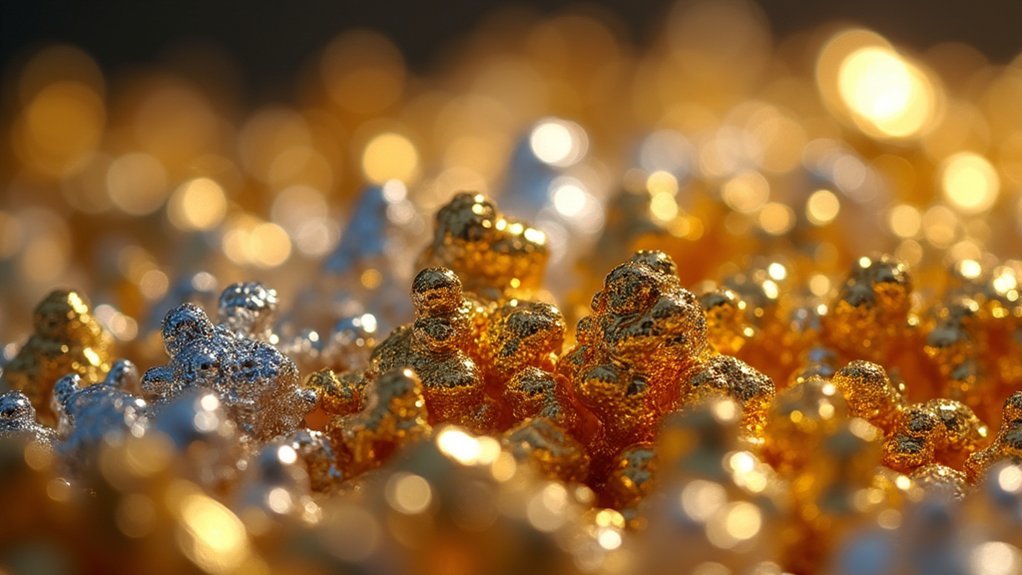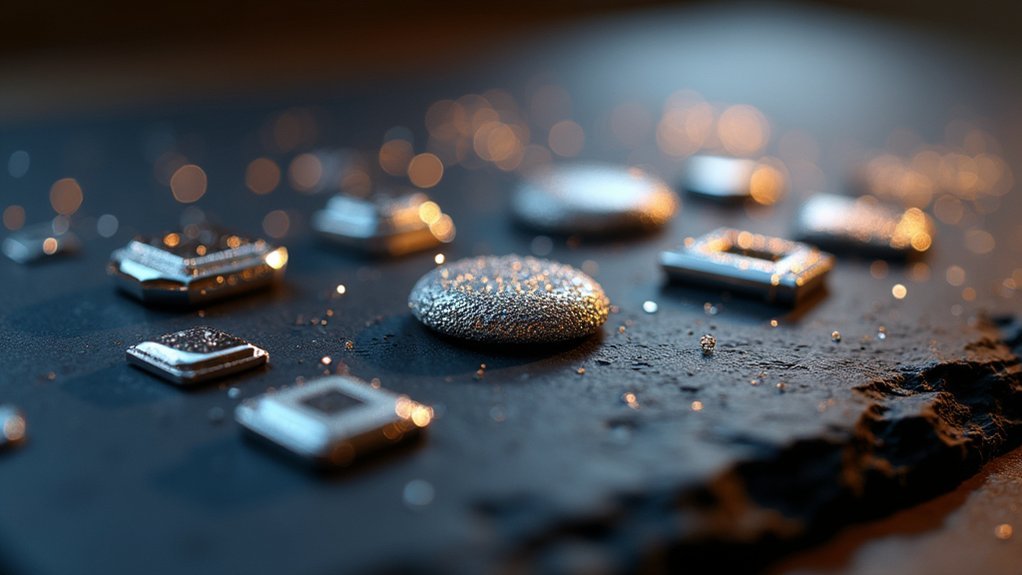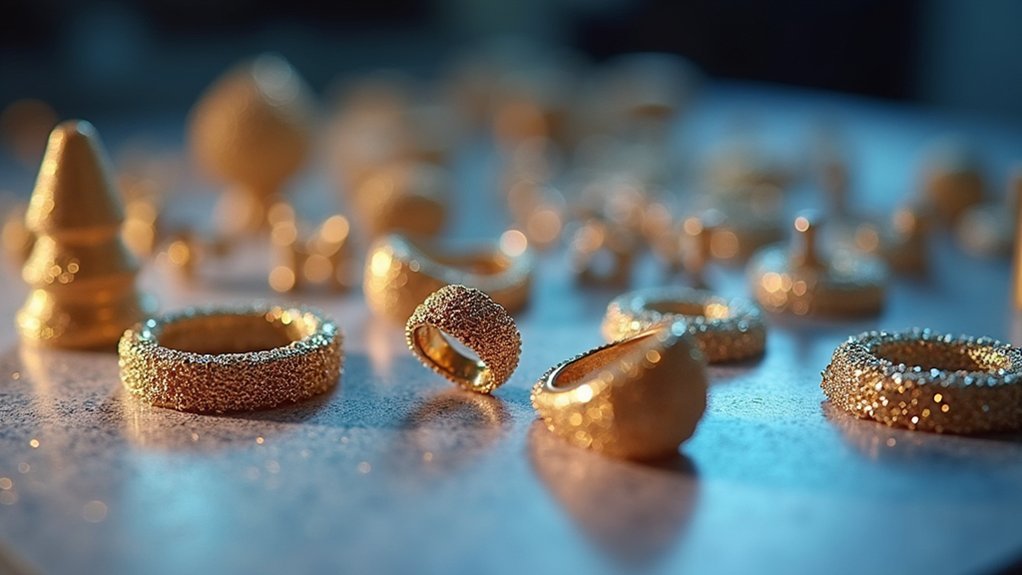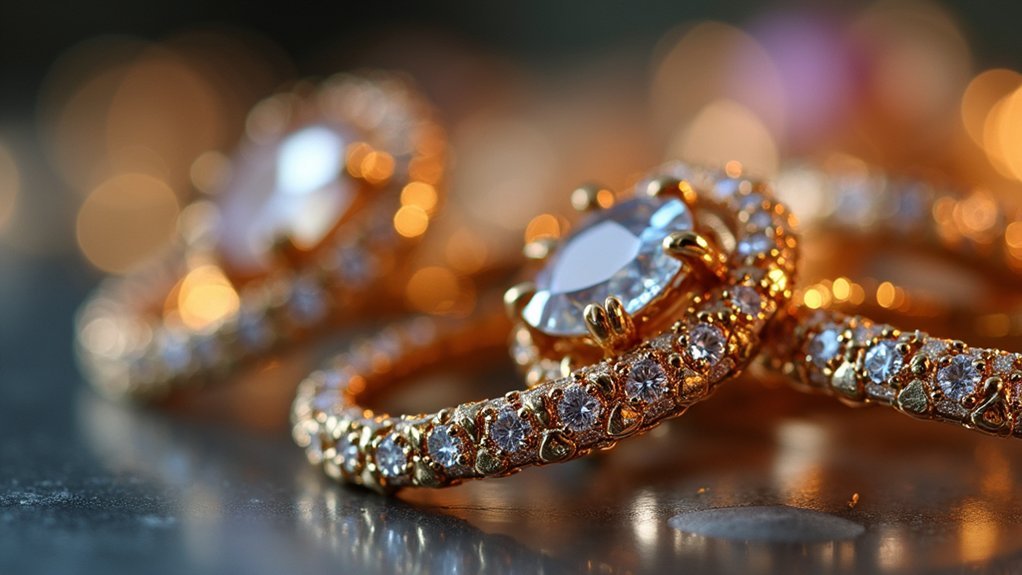You’ll achieve superior electroforming and electroplating results when you understand that silver’s 63 x 10^6 S/m conductivity outperforms all other precious metals in jewelry crafting applications. Copper follows closely at 59.6 x 10^6 S/m, making it ideal for electroforming due to its cost-effectiveness and malleability. Gold’s 45 x 10^6 S/m conductivity decreases further when alloyed, with 18-karat containing only 75% pure gold. Proper surface preparation and conductive coatings guarantee peak current flow for professional results that transform your metalworking capabilities.
Understanding Electrical Conductivity in Precious Metals

When you’re working with precious metals in jewelry crafting, understanding their electrical conductivity becomes vital for both traditional techniques and modern electronic applications.
Conductivity measurements in siemens per meter reveal significant differences between metals. Silver leads at 63 x 10^6 S/m, making it the most conductive precious metal available to jewelry makers. Gold follows at 45 x 10^6 S/m, while copper reaches 59 x 10^6 S/m.
Among precious metals used in jewelry crafting, silver demonstrates the highest electrical conductivity at 63 million siemens per meter.
Even sterling silver, containing 92.5% pure silver, maintains excellent conductivity despite alloying additions. You’ll find this knowledge vital when incorporating electronic components or using electroforming processes.
Gold’s superior corrosion resistance often outweighs its lower conductivity for electrical contacts, while silver’s exceptional conductivity makes it perfect for high-performance applications requiring maximum electrical flow.
Copper’s Superior Conductivity for Electroforming Applications
Among precious and semi-precious metals used in jewelry crafting, copper stands out as the ideal choice for electroforming applications due to its exceptional conductivity rating of 59.6 x 10^6 S/m.
This superior electrical conductivity enables efficient metal deposition during electroforming, delivering quicker processing times and more uniform layer thickness on your 3D printed models.
When you’re creating copper jewelry through electroforming, you’ll benefit from the metal’s natural malleability and ductility.
These properties allow you to achieve intricate designs with detailed features while maintaining strong bonds with conductive surfaces.
The combination of copper’s outstanding performance and cost-effectiveness makes it your best option for producing high-quality electroformed pieces without breaking your budget, especially for complex jewelry forms requiring precise craftsmanship.
Silver’s Exceptional Conductive Properties in Jewelry Making

Silver claims the title of the most conductive metal available to jewelry makers, boasting an impressive conductivity rating of 63 x 10^6 S/m that surpasses even copper’s excellent performance.
When you’re crafting silver jewelry, you’ll appreciate its high malleability, which allows you to create intricate designs without compromising conductive properties. This makes it perfect for pieces incorporating electronic components.
As a noble metal, silver resists corrosion, ensuring your jewelry maintains both conductivity and appearance over time.
Sterling silver offers an excellent compromise—you’ll get 92.5% pure silver’s outstanding conductive properties while gaining enhanced durability through alloyed metals.
The natural luster adds aesthetic appeal, making your functional jewelry pieces visually stunning while delivering superior electrical performance for specialized applications.
Gold Alloy Conductivity Variations and Their Impact
While pure gold delivers excellent conductivity at approximately 70% IACS, you’ll find that gold alloys present a more complex picture for jewelry making.
When gold’s alloyed with other metals like copper or nickel, conductivity drops considerably. Your 18-karat gold contains 75% pure gold and 25% other metals, reducing its electrical efficiency compared to 24-karat gold.
Lower karat values create even greater conductivity losses—10-karat gold with only 41.7% gold content performs much worse electrically.
The jewelry industry must consider these variations carefully. Rose gold’s copper content further diminishes conductivity, making it unsuitable for applications requiring high electrical performance.
Understanding your specific gold alloys’ composition becomes essential when designing conductive jewelry pieces or preparing items for electroplating processes.
Platinum Group Metals and Their Electrical Characteristics

When you’re working with platinum group metals (PGMs) in jewelry crafting, you’ll discover exceptional electrical properties that set these materials apart from traditional precious metals.
Platinum delivers outstanding conductivity at 10.1 x 10^6 S/m, making it perfect for high-end jewelry applications requiring electrical functionality. Palladium offers reliable performance with 9.0 x 10^6 S/m conductivity, excelling in electrical contacts and connectors that must withstand harsh conditions.
Platinum and palladium deliver exceptional conductivity performance, with platinum reaching 10.1 x 10^6 S/m for demanding electrical jewelry applications.
You’ll find rhodium particularly valuable as a plating material, enhancing durability and conductivity of electrical contacts despite lower inherent conductivity.
These metals’ resistance to corrosion and oxidation guarantees long-lasting performance in both decorative and functional jewelry pieces. Their low reactivity maintains consistent electrical characteristics while preserving aesthetic appeal, making PGMs ideal when you need both beauty and reliable electrical performance.
Preparing Metal Surfaces for Optimal Current Flow
You’ll achieve superior electroforming results by properly preparing your metal surfaces through systematic cleaning and conductive coating applications.
Start with thorough surface cleaning using ultrasonic baths, alcohol wipes, or abrasive polishing to remove oils, dust, and oxidation that block current flow.
Then apply conductive paints like graphite or copper coatings to guarantee consistent electrical contact across your jewelry piece’s entire surface.
Surface Cleaning Techniques
Three critical steps form the foundation of surface preparation for ideal electrical conductivity in jewelry electroforming.
You’ll need to master these surface cleaning techniques to guarantee your metal surfaces achieve peak current flow for professional jewelry-making techniques.
Start by thoroughly cleaning with warm soapy water and a soft brush, removing oils and residues that compromise conductivity.
Next, wipe surfaces with isopropyl alcohol or acetone to eliminate remaining contaminants.
Finally, sand or polish to create smoother textures that enhance adhesion.
Essential Surface Preparation Steps:
- Deep clean – Scrub away stubborn oils with warm, sudsy water
- Chemical wipe – Remove microscopic residues with alcohol solution
- Texture refinement – Polish surfaces to mirror-like smoothness
- Conductive coating – Apply conductive paint evenly across prepared areas
Test conductivity with a multimeter before proceeding with electroforming.
Conductive Coating Applications
Because non-conductive materials can’t naturally support electroplating processes, you must apply specialized conductive coatings to transform them into viable surfaces for jewelry electroforming.
You’ll need conductive paint or graphite-based solutions to create an even, smooth layer that guarantees ideal current flow during electroplating.
Create DIY conductive paint by mixing three parts graphite powder, twenty parts acetone, and one part superglue for a cost-effective solution.
Apply this mixture uniformly across your jewelry models, avoiding inconsistencies that cause uneven metal deposition and surface defects.
After application, perform conductivity tests to verify the surface can facilitate proper current flow.
Polish the coated surface to improve conductivity further, guaranteeing uniform electroplating that produces high-quality finishes on your final jewelry pieces.
Conductive Coating Techniques for 3D Printed Models

Several conductive coating options transform non-conductive 3D printed models into surfaces ready for electroplating, with conductive paint, graphite, and metal powders serving as the most effective solutions.
These conductive coatings enable both resin and FDM prints to achieve professional metallic finishes in jewelry making applications.
You can create effective DIY graphite paint by mixing:
- 3 parts graphite powder for ideal conductivity
- 20 parts acetone as the carrier solvent
- 1 part superglue for adhesion strength
- Polished surface finish to enhance metal deposition uniformity
After application, test conductivity using a multimeter to measure resistance levels.
Proper surface preparation guarantees even metal deposition during electroplating, preventing rough textures that compromise the final jewelry piece’s quality and appearance.
Testing Conductivity Before Electroplating Processes
Before you begin electroplating your 3D printed jewelry, you’ll need to verify that your conductive coatings are working properly through systematic testing methods.
You must prepare the surface correctly and use the right measurement tools to guarantee consistent conductivity across your entire piece.
Without proper testing, you’ll risk uneven metal deposition that can ruin your final jewelry design.
Essential Conductivity Testing Methods
When you’re preparing jewelry for electroplating, testing conductivity becomes your first line of defense against failed plating attempts.
You’ll need reliable methods to verify your jewelry piece is ready for quality metal deposition.
Essential Conductivity Testing Steps:
- Multimeter resistance testing – Set your device to measure resistance and probe the surface; low readings confirm excellent conductivity while high numbers indicate poor preparation.
- Post-application verification – Test conductivity after applying conductive paint to confirm complete coverage and proper adhesion.
- Surface polishing assessment – Smooth any rough conductive paint areas, as uneven surfaces compromise electroplating results.
- Final inspection protocol – Perform thorough conductivity testing across all areas before introducing your piece to the copper electrolyte solution.
These methods guarantee successful electroplating outcomes.
Pre-Electroplating Surface Preparation Requirements
Your conductivity testing confirms readiness, but proper surface preparation determines whether your electroplating succeeds or fails. After applying conductive paint or graphite coating to create your conductive surface, you’ll need to polish it thoroughly.
This polishing step improves conductivity while guaranteeing smooth, even metal deposition during the electroplating process.
Use a multimeter to perform final conductivity tests across the entire surface area. Check for consistent readings throughout your piece, identifying any weak spots that need additional coating. Focus on edges and detailed areas where coverage might be thin.
Proper surface preparation enhances adhesion between the conductive layer and deposited metal. Clean away any polish residue with isopropyl alcohol before electroplating.
This meticulous preparation prevents defects and guarantees uniform metal coverage throughout your jewelry piece.
Critical Measurement Tools Guide
Since accurate conductivity measurements determine electroplating success, you’ll need specific tools to verify your conductive surface before beginning the metal deposition process.
Proper measurement tools guarantee your jewelry piece will attract and hold the metal layer effectively during electroforming.
Essential conductivity testing equipment includes:
- Digital multimeter – measures electrical resistance with precision, where lower readings indicate superior conductivity for successful electroplating.
- Continuity tester – verifies your conductive layer creates complete electrical connections throughout the jewelry surface.
- Safety equipment – protective gloves and goggles for accurate testing in well-lit conditions.
- Testing probes – specialized contacts that provide reliable measurements on delicate jewelry surfaces.
Test your conductive paint or graphite coatings after application.
If resistance readings aren’t sufficiently low, polish or reapply the conductive layer before proceeding with the electroplating process.
Troubleshooting Poor Electrical Connections in Metal Work
Although electrical connections in metal jewelry work appear straightforward, poor conductivity can plague your projects and compromise electroforming or electroplating results. When you’re experiencing connection issues, start by cleaning all surfaces to remove oxidation and contamination that blocks current flow.
| Problem | Cause | Solution |
|---|---|---|
| Zero multimeter reading | Poor connection contact | Clean surfaces, remake connection |
| High resistance values | Corrosion or loose fittings | Tighten connections, remove corrosion |
| Inconsistent current flow | Contaminated surfaces | Use conductive paints on non-metals |
| Weak solder joints | Uneven heat application | Apply proper soldering technique with correct alloy |
Test conductivity between components using your multimeter regularly. When soldering, verify even heat distribution to minimize resistance. Maintain connections by inspecting for wear and corrosion that develops over time.
Enhancing Conductivity Through Proper Surface Treatment

When preparing surfaces for electroplating or electroforming, proper surface treatment dramatically improves conductivity and guarantees successful metal deposition.
You’ll need to create smooth, uniform surfaces since irregularities disrupt electrical current flow and compromise your results.
For non-conductive materials, you’ll transform them into conductive surfaces using specialized techniques:
- Apply high-quality conductive materials like copper paint or commercial conductive sprays to create an even metallic base layer.
- Polish the treated surface meticulously to remove imperfections and guarantee ideal electron flow throughout the material.
- Perform conductivity tests after treatment to verify the surface accepts electrical current before starting electroplating processes.
- Maintain uniform coating thickness by applying multiple thin layers rather than one thick application.
This careful surface treatment guarantees your electroplating achieves professional-quality results with seamless metallic finishes.
Frequently Asked Questions
What Is the Best Metal to Practice Jewelry?
You’ll want to start with copper for practicing jewelry making. It’s affordable, malleable, and forgiving for beginners. You can experiment with techniques without expensive mistakes while learning essential skills.
What Materials Should I Avoid in Jewelry?
You should avoid non-conductive plastics, wood, rubber, easily-corroded aluminum, toxic lead or zinc alloys, high-copper content metals that tarnish, and nickel-based alloys that aren’t hypoallergenic and cause skin reactions.
What Is the Most Sustainable Metal for Jewelry?
You’ll find recycled gold and silver are the most sustainable choices for jewelry. They eliminate mining’s environmental damage while maintaining quality. Alternatively, you can choose Fair Trade gold or explore durable platinum that’s easily recyclable.
What Is the Best Material to Make Jewelry Out Of?
You’ll find gold’s your best overall choice for jewelry making. It’s durable, hypoallergenic, and holds value well. Sterling silver’s great for affordability, while platinum offers unmatched luxury and longevity for special pieces.
In Summary
You’ll achieve superior electroforming results by selecting metals with ideal conductivity for your specific applications. Don’t overlook copper’s exceptional properties for base work, while silver and gold alloys offer distinct advantages for finishing. You must test conductivity before electroplating and guarantee proper surface treatments for reliable connections. Master these fundamentals, and you’ll consistently produce professional-quality jewelry with enhanced electrical performance and structural integrity throughout your crafting process.





Leave a Reply